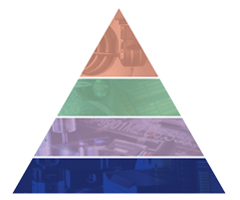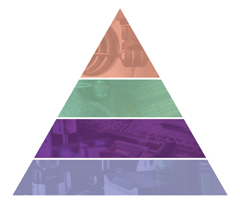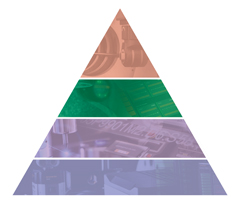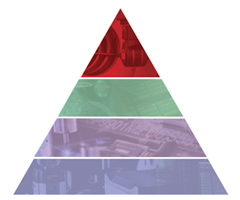Popraw produktywność
Poprawa produktywności dzięki usprawnieniu kontroli procesów produkcyjnych i osiągnięcie korzyści z tych działań.
- Większa wydajność istniejących maszyn
- Zwiększenie stopnia automatyzacji i obniżenie poziomu wpływu ludzkich błędów.
- Redukcja liczby poprawek, części dopuszczonych warunkowo oraz braków
- Zwiększenie możliwości i przyjmowanie większej liczby zleceń
Opanowanie zmienności procesu u samego źródła…
Zmienność procesu jest wrogiem konkurencyjności i dochodowości. Powoduje marnotrawstwo i nieefektywność, prowadzi do podwyższenia kosztów uzyskania jakości oraz wkładu pracy operatorów i jej skutkiem są opóźnienia dostaw oraz słaba jakość.
Sekret zapewnienia odpowiedniej automatyzacji i efektywności obróbki tkwi w zrozumieniu, skąd bierze się zmienność oraz opanowaniu jej źródła.
Piramida produktywności procesu (Productive Process Pyramid™) Renishaw stanowi opis procesu identyfikacji i kontroli zmienności w fabryce, wspieranego innowacyjną technologią, sprawdzonymi metodami oraz pomocą ekspertów. Renishaw może pomóc w zorganizowaniu produkcji przy zmniejszonej obsadzie operatorów lub obróbki bezobsługowej.
…i osiągnięcie długofalowych korzyści!
- uzyskanie większej wydajności istniejących maszyn
- zwiększenie stopnia automatyzacji i obniżenie poziomu wpływu ludzkich błędów.
- redukcja ilości poprawek, przeróbek, części dopuszczonych warunkowo oraz braków
- skrócenie czasu przygotowania produkcji
- zwiększenie możliwości produkcyjnych i zapewnienie jakości
- kontrola kosztów i poprawa wyników końcowych
Piramida Produktywności Procesu (The Productive Process Pyramid™)
Piramida produktywności procesu pokazuje, jak poszczególne warstwy kontroli mogą nakładać się na siebie, aby w sposób systematyczny usuwać zmienność procesu obróbki, zapewniając wzrost wydajności, maksymalizując zgodność i eliminując ludzkie błędy.
Cztery etapy
Przeanalizuj te cztery etapy, aby znaleźć klucz do przewidywalnego, wydajnego wytwarzania.
Podstawa procesu

Zadaniem warstwy podstawy procesu jest zapewnienie stabilnego środowiska roboczego, w którym ma być prowadzony proces. Obejmuje to optymalizowanie oraz monitorowanie parametrów działania samej obrabiarki.
Jest to kontrola zapobiegawcza, której celem jest obniżenie liczby źródeł zmienności przed rozpoczęciem produkcji.
Przygotowanie procesu

W warstwie przygotowania procesu rozpoznaje się źródła zmienności, takie jak położenie przedmiotu, wymiary i offsety narzędzi na obrabiarce, które mogą spowodować, że produkowane przedmioty nie będą odpowiadać wymaganiom.
Jest to kontrola prognostyczna, stosowana przed rozpoczęciem procesu obróbki.
Kontrola w trakcie procesu

Warstwa kontroli w trakcie procesu stawia czoła źródłom zmienności, które są typowe dla procesu obróbki, takim jak zużycie narzędzi i zmiany temperatury, dostarczając użytecznej informacji zwrotnej i pozwalając na podejmowanie decyzji w trakcie procesu skrawania.
Jest to kontrola aktywna, stosowana podczas procesu skrawania.
Kontrola poprodukcyjna

Ostatnia warstwa, kontrola poprodukcyjna, obejmuje sprawdzanie procesu i produktu finalnego względem ich specyfikacji, rejestrowaniem przebiegu oraz wyników procesu.
Jest to kontrola ostateczna, stosowana po zakończeniu procesu obróbki.
Czynności kontroli procesu
Każda z warstw Piramidy składa się z szeregu działań kontrolnych, które łącznie mają stawić czoła wszystkim źródłom zmienności procesu obróbki.
Dokumenty
-
 Broszura: Systemy metrologiczne przeznaczone do kontroli procesu produkcyjnego
Broszura: Systemy metrologiczne przeznaczone do kontroli procesu produkcyjnego
Poprawa produktywności dzięki usprawnieniu kontroli procesów produkcyjnych
-
 Publikacja: Kontrola procesu produkcji warunkiem utrzymania konkurencyjnej pozycji firmy
Publikacja: Kontrola procesu produkcji warunkiem utrzymania konkurencyjnej pozycji firmy
Wielu producentów szuka sposobów na obniżenie kosztów produkcji, równocześnie nie jest w stanie pozwolić sobie na zakup bardziej wydajnego wyposażenia. Jakie są zatem możliwości radykalnego obniżenia kosztów bez wymiany maszyn? Niniejszy artykuł przedstawia cztery obszary, w których firmy gotowe zmienić sposób kontroli procesu produkcji, mogą odnaleźć oszczędności.

